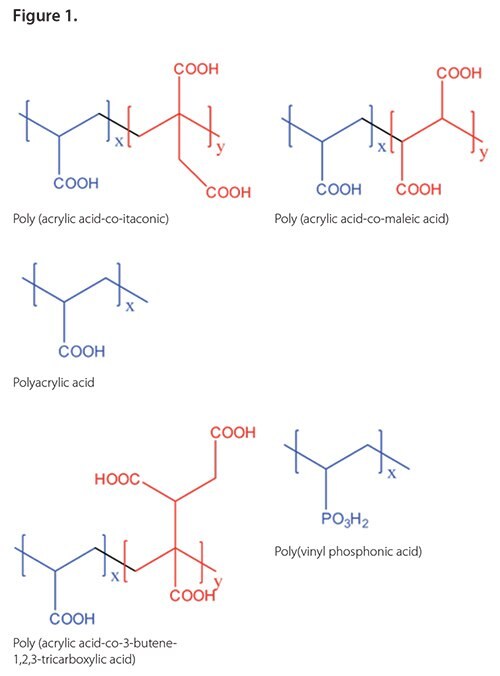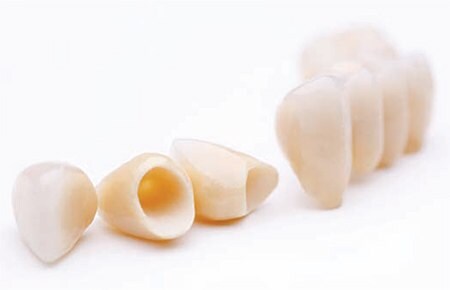Innovative Materials for Glass Ionomer Cements (GICs): Dental Applications
Ganga Panambur, Nicolynn Davis, Viktor Balema, Yong Zhang, Doug Harris, Bryce Nelson
Introduction
Innovation in dental restorative materials is driven by the need for biocompatible and natural-appearing restoration alternatives. Conventional dental materials like amalgam and composite resins have inherent disadvantages. Amalgam has poor aesthetics and contains mercury, which raises concerns over potential toxicity and release in the body. Resin-based materials offer improved aesthetics compared to amalgams, but resins are still limited by technique-sensitive adhesive properties and are time-consuming to apply. Glass ionomer cements (GICs) are an attractive alternative to amalgam and resin composites for use in dentistry.
GICs, also known as glass polyalkenoate cements, have several beneficial properties that make them useful for dental applications. GICs are primarily used for implant fixation and reconstructive surgical procedures; they can be placed in cavities and do not require bonding agents. By varying the composition, their physical properties can be tailored to the requirements of many different applications including sealing or lining a cavity floor, luting, core build-up, high fluoride releasing command sets, and pediatric cements.
Benefits of GIC Materials
GICs are increasingly used in many dental applications due to several inherent benefits:
- Safety
– Biocompatible with no inflammatory response or toxicity
– Bisphenol A and mercury-free - Excellent Physical and Chemical Properties
– Thermal compatibility and low thermal expansion
– Adhesion to mineralized tissue, enamel and dentin
– Adhesion with glass particles and base metals
– Stable and durable ionomer chemical structure - Easy-to-use
– Fast-setting
– Tunable physical properties by changing powder/liquid ratio
– Formulated to release fluoride as an anti-cariogenic - Aesthetically Attractive
Examples of Conventional Ionomers
Conventional GICs are predominantly composed of a composite of a polymeric ionomer such as polyalkenoic acid and silicate glass particles of 15-50 μM. During curing, the ionomer forms a network structure with the glass particles, and the carboxylate groups on the ionomer act as a network modifier to crosslink and form salt bridges with metallic ions. Conventional ionomers (shown in Figure 1) are homopolymers or copolymers of unsaturated mono, di- or tricarboxylic acids, or polyphosphonic acids.

The ionomer plays a very important role in the quality and properties of the GIC. GIC properties like cure time, adhesion and cement strength depend on the ionomer composition, structure, viscosity, molecular weight and polymer dispersity. The purity of the ionomer, especially the trace monomer and oligomer contents, is also very important in determining the final properties of the GIC.
Innovative Ionomers for Next Generation of GICs
Despite their many advantages, conventional GICs still exhibit relatively poor mechanical properties. This leads to low fracture strength, less toughness and lowered durability. In particular, the low tensile strength of existing GICs makes them unsuitable for use in high stress sites such as class II restorations, particularly where there is lack of support from the cavity wall. For these reasons, the use of conventional ionomers is limited to non-stress bearing restoration. New formulations of GICs have been developed to improve these properties and to increase resistance to fracture, wear and erosion.
Improved GIC formulations include:
- Resin-modified glass ionomer cements (RMGIC): Addition of polymerizable resins to the GIC formulation improves mechanical and physical properties, including adhesiveness and translucency.
- Hybrid ionomer cements (dual-cured, and tri-cured): To increase strength, photocurable monomers are added to the GIC. The hybrid material undergoes the acid-base ionomer reaction and photo-initiated curing. Initial setting of the cement is induced by photochemical polymerization and protects the cement from early moisture. Tri-cured GICs contain a chemical curing agent in addition to the photo-initiated and acid-base reactions.
- Reinforced GICs: The addition of metal powders or fibers to GICs can improve overall strength. Incorporation of alumina, silica or carbon fibers to the GIC will improve flexural strength.
- Bioactive Glass Ionomers: Bioactive glass added to GICs can improve tooth bioactivity, regeneration capacity and restoration. Bioactive glass may assist with re-mineralizing dentin.
Design of Novel Ionomers
We are developing synthetic methods that result in greater control over ionomer copolymer properties. Developing a robust ionomer synthetic method is critical to obtain ionomers with desired and reproducible properties. Conventional ionomer copolymers are synthesized with acrylic acid and di/tri carboxylic acid monomers, which have different intrinsic reactivities. As a result, conventional ionomer synthesis methods are challenging to control molecular weight, polydispersity and composition. The optimized synthetic process uses controlled reaction conditions, defined monomer feed ratio and controlled monomer and catalysts additions to make ionomers with precise physical and molecular properties.
We now offer a number of new monomers with extended linkages for improved GIC properties. Current ionomers have carboxylic acid groups closely attached to the polymer backbone. As the cement vitrifies, the close attachment prevents the effective conversion of the carboxylic acid groups to ion bonding carboxylate groups during curing reaction, thereby reducing the formation of salt-bridges. Introduction of monomers with various spacer lengths of the carboxylic acid groups could improve the properties of the cement by enhancing salt bridge formation.

In addition, we are developing polyacrylic acid-free ionomers. Polyacrylic acid, even in ppm concentrations, is known to limit bioactivity and inhibit apatite formation on GIC surfaces. Alternative ionomers that are polyacrylic acid-free may have improved apatite formation and improved performance.
Our Custom Manufacturing Capabilities
Innovative and high quality raw materials are essential for new dental formulations. We offer a selection of ionomers and monomers for dental R&D and commercial applications, as well as manufacturing capabilities to customize or produce monomers to customers’ specifications, reducing the total cost of product development and manufacturing.
To learn more, visit sigma-aldrich.com/dental or download the PDF
如要继续阅读,请登录或创建帐户。
暂无帐户?